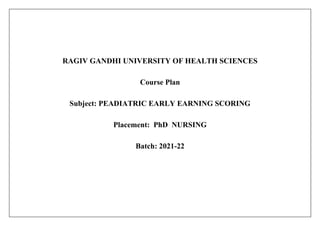
Rresearch Syllabus.docx
- 1. RAGIV GANDHI UNIVERSITY OF HEALTH SCIENCES Course Plan Subject: PEADIATRIC EARLY EARNING SCORING Placement: PhD NURSING Batch: 2021-22
- 2. SUBJECT: PEADIATRIC EARLY WARNING SCORING SYSTEM ALLOTTED HOURS: 70 hours COURSE DESTRIPTION This course is designed to enable students to develop an understanding the basic concepts of Paediatric early warning score system. It will also enhance students critical thinking and ability to identify clinical status of children. GENERAL OBJECTIVE On completion of the course, the students will be able to acquire knowledge on PEWS develop skill in method of scoring system and early detection of deterioration of children. It will enable them to identify complications early to improve children outcome.
- 3. SPECIFIC OBJECTIVES On completion of this program students will be able to 1. Describe history of Paediatric critical care 2. Appreciate the methods of assessment and interpret the abnormal 3. Students will be able to identify early detection of clinical status of children 4. Use communication skills appropriately with health care personnel in their clinical practice 5. Demonstrate PEWS charting effectively in Paediatric patients 6. List the benefits of PEWS and use it in clinical practice 7. Describe the different hospital policies regarding PEWS implementation 8. Analyses the research studies and report related PEWS
- 4. COURSE PLAN UNIT SPECIFIC OBJECTIVE TIME (Hours) CONTENT Unit -1 Students will be able to describe history of Paediatric critical care 4 History of Paediatric Critical Case (a) Critical Care Nursing (b)Monitoring (c) Documentation (d)Policies of transfers from ward to PICU/NICU Unit-2 Students will be able to appreciate the methods of assessment and interpret the abnormal 6 Paediatric Assessment (a) Methods (b)Clinical Parameters (c) Normal Values (d)Abnormalities/Variations Significance (e) Clinical deteriorations- Nurses Role Unit- 3 Students will be able to demonstrate the skills in identify early detection of clinical status of children 5 Nurses Role (a) Early detection and management of clinical deterioration of children (b)Alerting Rapid Response Team function (c) Algorithm of action and documentation
- 5. Unit- 4 Students will be able to use communication skills appropriately with health care personnel in their clinical practice 5 Communication to other health care members (a) Oral communication (b)Telephonic communication (c) Charting (d)Reporting (e) Code blue alerts Unit-5 Students will be able to demonstrate PEWS charting effectively in Paediatric patients 5 6 Assessment Tools (a) MEWS (b)BPEWS (c) PEWS Charts Development of PEWS (a) Purposes (b) PEWS models & Validation (c) Review of PEWS Scores (d) Method of charting (e) Effectiveness of PEWS in patient care
- 6. Unit -6 Students will be able to list the benefits of PEWS and use it in clinical practice 2 4 (Practicals) 4 (Theory) Benefits of PEWS (a) Patients (b)Health care team (c) Organization Education and training of Nurses (a) OSCE Teaching Application of PEWS and clinical practice (a) Emergency Wards (b)Paediatric Wards (c) PICU Unit-7 Students will be able to describe the different hospital policies regarding PEWS implementation 6+6 (Practicals) Hospital Policies related to PICU transfers (a) Rapid Response Team- alerts (b) Action Algorithm (c) PEWS Implementation (d) Audit Report
- 7. Unit-8 Students will be able to analyses the research studies and report related PEWS 10 Research studies on PEWS implementations (a) Effectiveness of PEWS in improving clinical outcome of children (b)Health care personnel opinion (c) Sensitivity of PEWS to identify clinical status of children (d) PEWS implementation in limited rural setting.